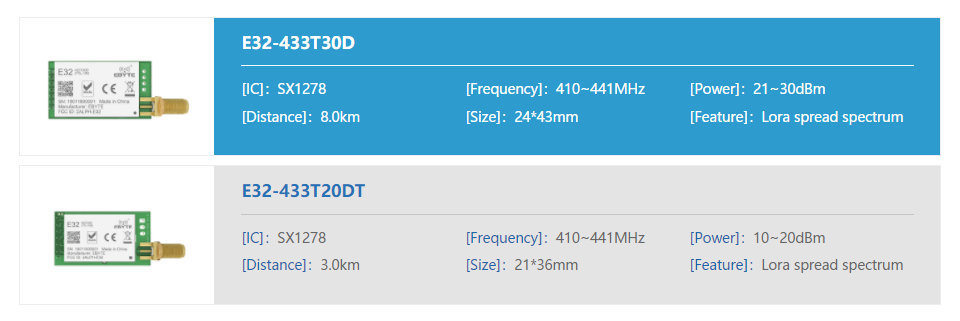
With the development of wireless data transmission, the application of wireless modules has become more and more widespread. Wireless modules are widely used in vehicle monitoring, remote control, telemetry, small wireless networks, wireless meter reading, access control systems, cell paging, industrial data acquisition systems, wireless tags, identification, contactless RF smart cards, small wireless data terminals, security fire protection System, wireless remote control system, biological signal acquisition, hydro-meteorological monitoring, robot control, wireless 232 data communication, wireless 485/422 data communication, digital audio, digital image transmission and other fields.
The transmission distance of the wireless module is mainly affected by factors such as power, receiving sensitivity, and antenna. The methods for increasing the transmission distance of the wireless module are mainly described from these three aspects.
1. Emissive power
Emissive Power is the strength of the RF signal emitted by the wireless module. Theoretically, the greater the RF signal strength is, the longer the transmission distance is, i.e., the high-power wireless module has a longer transmission distance than the low-power wireless module.
》For example, the comparation of E32 modules from Ebyte

As shown in the figure, the frequency of the two modules is 433MHz. Both are UART interface and based on SX1278, the transmitting power is not the same, so the transmitting distance is definitely different. From the theoretical comparison, E32-433T20DT has a small power and a closer transmission distance; E32-433T30D has a larger power and a longer transmission distance.
2. Receiver Sensitivity
Receiver sensitivity (Receiver Sensitivity) refers to the minimum signal strength that can be detected by the receiver when the receiver demodulator requires SNR. The receiving sensitivity of wireless transmission is similar to the hearing of people when they are talking. Increasing the receiving sensitivity of the signal allows wireless products to have a stronger ability to capture weak signals. In this way, as the transmission distance increases, the received signal becomes weak, and high-sensitivity wireless products can still receive data, maintain a stable connection, thus greatly increase the transmission distance. That is, the lower the receiving sensitivity, the farther the wireless module transmits.
The formula for receiving sensitivity is as follows: S=-174+NF+10lgB+10lgSNR
NF is the noise figure, B is the signal bandwidth, and SNR is the demodulation signal-to-noise ratio. The larger the bandwidth, the greater the noise figure of the system, the greater the sensitivity, and the worsening of the receiving performance. This requires that when designing the receiver, the influence of the system's bandwidth and noise figure on the sensitivity must be taken into consideration.
The receiving sensitivity of the wireless module is very important, especially in the low-power transmission system, each dB is very important, especially "6dB principal": That is to increase or decrease 6dB, mean to increase or reduce half the power by half. For example, if the transmitter’s transmit power is 100mW(20dBm), and the receiver sensitivity at 11Mbps is -83dBm, the theoretically unobstructed line-of-sight is 15km. And when the receiver sensitivity is -77dBm, the theoretically unobstructed line-of-sight is only theoretically transmitted for a half of the 15km (7.5km). Or equivalent to the launch end, the energy is reduced by 1/4, which is equivalent to 25mW(14dBm). Therefore, improving the receiving sensitivity of the receiving end in the wireless module transmission system is equivalent to increasing the transmitting energy of the transmitting end, and at the same time increasing the transmission distance of the wireless module.
3. Antenna
Antenna is an inverter that transforms a guided wave propagating on a transmission line into an electromagnetic wave propagating in an unbounded medium or vice versa. The general antenna is reversible, that is, the same sub antenna can be used as both a transmitting antenna and a receiving antenna, and the same antenna is act as the same characteristic parameter for both transmitting and receiving.
Theoretically, the input impedance and the gain of the antenna can determine both the performance of the antenna and determine the transmission distance of the wireless module. From the perspective of the input impedance of the antenna, the standard is 50 ohms, and the impedance of the wireless module is also 50 ohm. This way the antenna and the wireless module are completely matched to ensure that no loss of transmission signal occurs, thereby ensuring the distance of the wireless module. From the aspect of the gain of the antenna, the total transmitted energy is equal to the sum of the transmitted power (dBm) and the antenna gain (dBi). The larger the antenna gain, the greater the total transmitted energy, and the farther the wireless module transmits.
From the actual test of the antenna, since the actual environment on the site cannot be absolutely flat, such as hills, buildings, and trees. Therefore, before the implementation of the project, it is necessary to conduct on-site radio wave propagation and receive field strength tests (accuracy to a certain number of dBm), so that parameters such as power, antenna type, and erection height of the equipment can be determined according to the site environment and work requirements. So that the uplink and downlink signals can be reached Sufficient anti-jamming capability can achieve effective and reliable wireless data transmission.
》For example, the comparation of 433MHz antennas from Ebyte.

As shown in the figure, the impedances of the three antennas are all 50 ohms, and the VSWR is also less than or equal to 1.5. Only the gain is different, so the transmission distance must be different. From the theoretical comparison, the TX433-JZG-6 has the smallest gain and the shortest transmission distance, followed by the TX433-JK-20, and the TX433-XP-200 has the larger gain and the longer transmission distance.
However, in actual tests, it cannot be absolutely flat and no obstructions. Therefore, the transmission distance of a wireless module is affected by many factors, and there is no absoluteness.